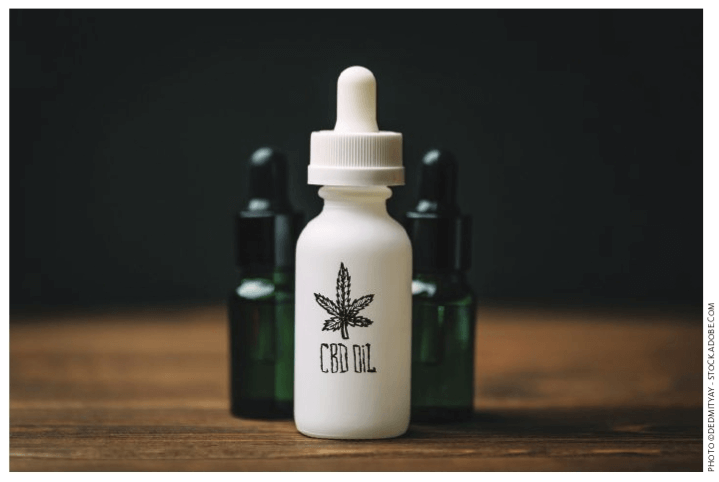What Can You Expect?
By Juliet M. Getty, Ph.D.
 CBD. Whether you’re already using it, you’re thinking about it, or never heard of it, it’s worth getting more familiar with because it is truly remarkable. No, it’s not the latest snake oil touting cures from hair loss to ingrown toenails. Instead, it is a chemical messenger in the endocannabinoid system, a natural and crucial part of the body. Research on this system is extensive, with years of examination and hundreds of studies.
CBD. Whether you’re already using it, you’re thinking about it, or never heard of it, it’s worth getting more familiar with because it is truly remarkable. No, it’s not the latest snake oil touting cures from hair loss to ingrown toenails. Instead, it is a chemical messenger in the endocannabinoid system, a natural and crucial part of the body. Research on this system is extensive, with years of examination and hundreds of studies.
My goal in writing this article is to offer you an overview of how CBD can impact your health as well as the health of your horses, dogs, and cats. From a personal perspective, I have experienced significant pain relief from sciatica. Many of my clients have decided to use it for themselves, offering them better sleep, lessened anxiety and depression, improved digestive health, allergy relief, and reduced pain.
Chester is my 22-year-old horse. He suffers from arthritis in his hocks and knees and is now moving with much greater ease. Clients who have decided to try CBD for their horses have offered very positive feedback. Inflammatory conditions such as arthritis and ulcerations are showing improvement, as well as pain relief from laminitis. Horses with anxiety or “sensitive” behavior have a more relaxed demeanor. And metabolic conditions may be potentially alleviated, which is quite exciting.
While it’s too soon to tell if leptin and insulin levels are declining from CBD treatment, there have been studies showing how CBD reduces insulin resistance and obesity, as well as appetite, in people with type 2 diabetes and metabolic syndrome.
What is CBD, and is it marijuana?
CBD is short for cannabidiol; it’s one of more than 80 different cannabinoids found in the cannabis plant. CBD and THC are the two most studied, and this is where many misunderstandings stem from.
Cannabis sativa L. (genus, species, and subspecies) is the “umbrella term” for the plants known as hemp and marijuana. Marijuana is particularly high in THC, the cannabinoid that creates a psychoactive “high.” CBD, on the other hand, does not create this effect.
Hemp-derived CBD is Not Marijuana
Though both hemp and marijuana belong to the Cannabis genus, their genetic composition distinguishes them to produce vastly different amounts of THC. Hemp-derived CBD is high in CBD and very low in THC (less than 0.3%).
Though hemp-derived CBD is legal in all 50 states (thanks to the passing of the 2018 Farm Bill) federal law does not preempt state law, and there are still some restrictions within various states. Just as many cities throughout the country prohibit alcohol sales, there are local and state laws that restrict industrial hemp products. But bottom line—it is legal to purchase and consume hemp-derived CBD products. The FDA does not regulate it, so it behooves you to choose a reputable company that is willing to disclose the source, extraction method, and analysis of their products.
What is the endocannabinoid system?
The endocannabinoid system (ECS) is a major signaling system that exists in you and your animals. It continually monitors any instability within the body and returns it to a state of balance or homeostasis so that the internal environment remains stable.
CBD and other cannabinoids are compounds that activate this system. Cannabinoids, both naturally produced by the body (endogenous), and those supplemented from cannabis (exogenous), act as “keys” to these receptors, turning on a variety of functions.
Within the ECS there are two main cell receptors—CB1 and CB2
CB1 receptors exist mainly in the brain and central nervous system. They impact areas such as appetite regulation, memory, emotions, and feelings of pain.
CB2 receptors are concentrated in the gastrointestinal tract and peripheral nervous system (nerve cells outside the brain and spinal cord) and modulate immune cell functions. When activated, they help reduce inflammation.
Endogenous cannabinoids are produced when the body signals that they are required but are quickly degraded. Offering CBD (exogenous cannabinoid) allows the ECS to work harder and be more productive to help us and our animals deal with health issues such as:
- Anxiety and depression
- Insomnia
- Pain and inflammation
- Obesity/increased appetite/leptin resistance
- Metabolic syndrome/insulin resistance
- Immune deficiencies and autoimmune diseases
- Digestive disturbances/ulcers/colitis
Side Effects
CBD has a favorable safety profile. If overdosed, it can have some mild effects. These can include drowsiness, decreased blood pressure, dizziness, fatigue, and diarrhea. If you or your animals experience any of these, you can cut back on the dosage. Long-term use appears to be safe, though further research is needed.
Noteworthy: Until we know more, CBD should not be taken by pregnant women. Consult your veterinarian before giving it to a pregnant animal. It should not be given to children without professional permission. Since it can interact with some drugs, including anti-epileptic and blood thinner medications, it is best to consult with your doctor or pharmacist when you have any doubts.
Let’s Talk Horses
As of this date, there are few, if any, research studies that use horses as subjects. But I expect this will quickly change as more and more companies are selling CBD for equine consumption. In the meantime, anecdotal responses are highly favorable. From first-hand accounts of horse owners, hemp-derived CBD appears to stimulate the horse’s ECS in the same way it does yours. It is well tolerated, without any euphoric or adverse effects. Specific health conditions that CBD may improve, based on currently available studies with humans and laboratory animals include:
- Pain from arthritis or laminitis
- Anxiety during stall confinement
- Stress during traveling and shows
- Ulcers and leaky gut
- Healing from surgery or injury
- Immune system depression from oxidative stress experienced with Cushing’s disease
- Appetite regulation
- Obesity
- Inflammation, with the potential to reduce leptin levels
- Insulin resistance
Horse Competition Rules and Testing
The FEI (International Federation for Equestrian Sports) and the United States Equestrian Federation (USEF) have strict rules regarding medicating your horse prior to an event. Recently, the USEF announced that as of September 1, 2019, positive test results for cannabinoids will incur violations.
Since it is THC that is detectable by a blood or urine test, it is highly unlikely for a positive test result to occur since hemp-derived CBD contains only minute amounts of THC. Nonetheless, it is possible, so it is best to discontinue its use 7 to 10 days prior to an event. Even if you choose a CBD isolate or broad-spectrum product (which does not contain any THC), it is best to err on the side of caution by stopping before an event.
Choose a Safe, Quality Product
First, know where the hemp was grown. Choose products grown in the US or Canada. If it was grown overseas with potentially relaxed growing standards, it could be contaminated with chemicals, bacteria, and heavy metals that put your (and your horse’s) health at risk.
To ensure a clean, safe product, it is best to buy CBD that has been tested and offers a Certificate of Analysis (COA) posted on the company’s website This document shows how the company meets and adheres to product specifications and standards of production.
Other things to pay attention to with CBD products:
- Check the label for accurate CBD content per dose
- Choose a product from an organic source
- Look for percentage of THC on a provided COA
CBD Isolate, Full-spectrum, or Broad-spectrum
CBD isolate means that the product contains only CBD with no other naturally occurring cannabinoids, including THC. That also means that other substances that are found in the plant, such as terpenes and flavonoids, have been fully extracted.
If you are undergoing a drug test for a job, it is best to use the isolate, or stop your usage of the full spectrum product a week or two before the test.
Full spectrum is a whole plant CBD, meaning that it contains CBD and other cannabinoids (less than 0.3% THC), as well as terpenes, flavonoids, and active essential oils.
Broad-spectrum products also contain the whole plant compounds like full spectrum, but the THC has been removed.
The Entourage Effect
It used to be thought that CBD isolate was the best approach. But it’s now better understood that the cannabinoids and plant compounds found in full-spectrum and broad-spectrum CBD create a synergism where they work together to complement each other, offering a greater impact on health conditions.
It’s important to note that dogs and cats can benefit from hemp-derived full-spectrum CBD, even though they cannot tolerate THC from marijuana. The tiny amount of THC found in this product is safe and may further increase the entourage effect.
Why is it so expensive?
It takes a lot of hemp plants to create a CBD oil (tincture). Products called “hemp oil” are not necessarily concentrated with CBD. Hempseed oil is a nutritious oil, high in essential fatty acids, but it is not a good source of CBD. Before you buy, read the label carefully to determine just how much CBD exists in the product.
What extraction method is best?
When researching a CBD product for you and your animals, it is best to know the extraction method used to remove CBD from the plant. Going through each method is beyond the scope of this article, but the approach that is most complete and the cleanest is a CO2 extraction. It uses carbon dioxide (CO2) to extract CBD from the plant to create products that are pure and very powerful.
How much CBD is in one dose?
The label should provide you with the amount of CBD per dose, but it can be confusing.
When using a CBD tincture, you should see the number of mgs of CBD in the full bottle. Some products can be very diluted, so be sure the manufacturer’s label is detailed and specific.
Many tinctures will offer directions by the “dropper-full.” But getting a full dropper is not always possible or can be inaccurate. The best approach is to first determine the amount of CBD in each drop. By knowing how many mgs are in each drop, you can accurately dispense the desired dosage.
To do this, you need to know these three things: 1) There are 30 ml of oil in a typical CBD tincture bottle, 2) a full dropper-full is 1 ml, and 3) there are 20 drops in a ml.
Two examples:
- CBD tincture that offer 2500 mg of CBD in the entire 30 ml bottle:
- Divide 2500 by 30 to get the number of mg per dropper-full (1 ml). This calculates to be 83.3 mg of CBD in 1 ml
- Divide 83.3 by 20 to give you the level of CBD per drop. This calculates to be approximately 4 mg per drop.
- CBD tincture for pets that offers 250 mg of CBD in the entire 30 ml bottle:
- 250 divided by 30 = 8.3 mg of CBD in one dropper-full (1 ml)
- 3 divided by 20 = .42 mg (slightly less than ½ mg) of CBD per drop
Other forms of CBD such as pellets, gummies, capsules, and topicals should offer specific amounts of CBD per dose.
What is the best dosage?
Dosages are weight dependent and based on the severity of the situation. It is best to start slowly, and then increase the dose as needed. A little trial and error is necessary to find the right dose that is best for you or your animals. Keep in mind that it takes approximately 2 weeks for the body to experience relief and will continue to improve over time.
Dosage recommendations are not standardized. However, through research studies and applications, here are generalized daily guidelines. I have found that dividing the dose into two servings is better than administering once daily.
Pets:
Under 25 pounds: 10 mg
25 to 75 pounds: 10 to 20 mg
75 or more pounds: 20-40 mg
People:
Less than 100 pounds: 20 to 40 mg
100 to 174 pounds: 30 to 60 mg
Over 175 pounds: 60 to 90 mg
Horses:
Minis: 25 to 50 mg
Full sized (1100 pounds): 75 to 170 mg
Large breeds: 120 to 200 mg
How to administer CBD
There are several ways to provide CBD:
- Sublingual:Placing the drops under the tongue and holding them there for 30 seconds provides good bioavailability and kicks in quickly. This is difficult to do for animals and is not recommended since most droppers are made of glass and can cause injury if bitten.
- Oral:Adding CBD to food, swallowing a CBD capsule, or chewing a CBD gummy, will take the longest time for the effects to become apparent, but this method is longer lasting than under the tongue. Pellets (typically available for animals) that are extruded are better absorbed than pellets that use binders, providing improved bioavailability and hence, lower effective dosing.
- Pulmonary:CBD vapes are available. While this has the highest bioavailability, it has the shortest duration of action. I typically do no recommend this for people with any respiratory conditions, since it could be potentially harmful.
- Topical:Worthwhile for you and your animals. CBD is absorbed well into the skin and is beneficial for targeted areas.
Bottom line
Even though experts have been studying for decades the benefits of CBD, there is still research that needs to be done, especially for horses. Nevertheless, the outcome thus far is encouraging, revealing long-reaching benefits on the natural endocannabinoid system, providing relief from mental and physical ailments that affect us, our families, and our animals.
For a list of sources for this article visit Dr. Getty’s website at www.gettyequinenutrition.com

Juliet M. Getty, Ph.D. is an independent equine nutritionist with a wide U.S. and international following. Her research-based approach optimizes equine health by aligning physiology and instincts with correct feeding and nutrition practices. Dr. Getty’s goal is to empower the horseperson with the confidence and knowledge to provide the best nutrition for his or her horse’s needs. Learn more at www.gettyequinenutrition.com.




